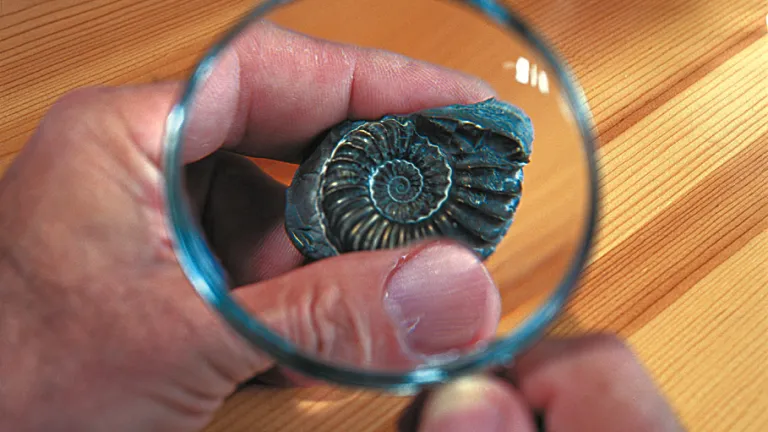"A Fish Out of Time"
When a fish believed to be extinct for 65 million years was found in the Indian Ocean, evolutionists were stumped as to why it hadn't evolved at all in all those millions of years. The more we learn about this amazing fish, the more it casts doubt on the evolutionists' interpretation of the geologic record.
In 1938 a fishing trawler off the coast of South Africa near East London made a discovery that astonished the scientific world. The trawler had caught a fish that was supposed to have been extinct for 65 million years—the coelacanth. This was the first time this fish was discovered in modern times. Previously, it was thought that coelacanths only existed until the end of the geologic period called Cretaceous.
The fish was examined and named Latimeria chalumnae by Professor J.L.B. Smith of South Africa. Coelacanths have been called "living fossils" because they have not changed, according to the geologists, over 400 million years.
Why are coelacanths such a puzzle to the scientific world? The answer is found in the way that geologists divide time by "geologic periods." According to modern geologic theory, life has evolved from very simple forms in ancient times to the more complex forms we find on earth today.
Coelacanth fossils are found during the geologic period called Cretaceous. The Cretaceous period ended around 65 million years ago (by evolutionary standards) and coelacanth is not found in any "younger" strata. During this same period dinosaurs also roamed the earth.
Not only does coelacanth disappear from the geologic record, but also it has not changed during this "geologic time." However, the environment has changed radically in the last 65 million years. If evolutionary processes had really happened, there should be no creatures in existence today identical to those from 65 million years ago. The evolutionary process surely would have acted on every creature during this period of time.
Thus, the coelacanth is a mystery to evolutionists. As one article states: "The rediscovery of the coelacanth in 1938 was the marine equivalent of stumbling across a living dinosaur...The Latimeria remains an enigma. How has it survived 70 million years after all other coelacanths have become extinct?" (Prime Club Magazine, Vol. 6, No. 4, "Diving With Dinosaurs," pages 26-27.) Finding coelacanths is like finding groups of small dinosaurs alive today in the jungles of Africa!
Not only have coelacanths been found alive, but in more than one location. "After their rediscovery, coelacanths were observed only in or around the Comoros, a small cluster of volcanic islands between southeastern Africa and Madagascar. As a result, it was believed that coelacanths inhabited only a limited range in the western Indian Ocean. In 1998 reports of another population more than 10,000 km (6,000 mi) to the east of the Comoros, shattered that long-held belief. First spotted near the eastern Indonesia island of Sulawesi, the newly discovered coelacanth population is the subject of intense scientific investigation" (Encarta Encyclopedia, 1997-2003, "Coelacanth").
Another problem for evolutionists is that coelacanths are more numerous and widespread than first believed. This adds further doubt to the validity of the evolutionists' "geologic periods." Now it is known that coelacanths have been sold in the markets of Indonesia for quite some time. Some scientists speculate that coelacanths may exist in other parts of the earth and have not yet been discovered because they tend to live deep in the ocean where it is difficult to find them.
An Amazing Creation
Coelacanths are an amazing creation of God, as evidenced by their unusual way of searching for prey. "The coelacanth has often been seen to perform head-stands, in which it rotates its body into a vertical position, with its head near the bottom and its caudal fin curved perpendicular to its body. It holds this position for two to three minutes at a time. This curious behavior may be used to scan the bottom with its rostral organ, which is thought to be an electro-receptive organ that helps it to locate prey" ("Diving With Dinosaurs," page 27).
Here is a fish that has existed over 400 million years according to the "geologic column," yet it uses some type of advanced mechanism to find its prey. Where is the simple-to-complex advance that is claimed by evolutionists to be demonstrated by the geologic record? This creature is very advanced and found in strata dated at 400 million years. We can see why the word enigma is so common when articles about coelacanth are written.
The mystery of why coelacanth was discovered only recently can be explained when it is understood where the coelacanth lives. It is impossible for them to live near the surface of the ocean because they cannot absorb oxygen in sufficient quantities. Their design enables them to live at a depth of around 800 meters (about 2,600 feet) below the surface of the water.
Another Interpretation of the Geologic Record
What if there was another interpretation of the geologic record? If the geologic record is not the record of "evolution" slowly over millions of years, but is the record of a series of catastrophes, then trilobites and fish that live deep in the ocean would tend to be buried lower than fish or other creatures who lived on land or near the surface of the water. Because coelacanths live at great depths, their fossils would tend to be buried deeper in the strata of the earth. This is very likely the true explanation of why coelacanths are not found in "modern" geologic strata.
My wife, Cheryl, and I had the opportunity to visit a museum in East London, South Africa, last year that gives the entire story of how coelacanth was found and identified. On display is the first coelacanth caught, a model of the vessel from which the fishermen caught it and other relevant items. It is a modern mystery for scientists to explain, as coelacanth represents strong evidence for creation. It has not changed for over 400 million years, according to their theory, and is missing from geologic strata for the last 65 million years.
Misconceptions
Before coelacanth was discovered, scientists had many misconceptions about how it lived and what the functions of its fins were. Michael Denton states in his book, Evolution: a Theory in Crisis: "Further, there is always the possibility that groups, such as the mammal-like reptiles which have left no living representative, might have possessed features in their soft biology completely different from any known reptile or mammal which would eliminate them completely as potential mammalian ancestors, just as the discovery of the living coelacanth revealed features in its soft anatomy which were unexpected and cast doubt on the ancestral status of its rhipidistian relatives" (1985, page 182).
In other words, because scientists only had fossils of coelacanth to work with, they misinterpreted how the coelacanth functioned and how its internal organs work. The theory that it walked on the bottom of the ocean was completely erroneous. In reality it assumes a vertical position when it is seeking prey. They had no idea of the modern theory that coelacanth had an "electro-receptive" sensing organ that it used to catch prey.
Coelacanth is indeed an incredible wonder of creation! Truly, it supports the apostle Paul's statement in Romans 1:20: "For since the creation of the world His invisible attributes are clearly seen, being understood by the things that are made, even His eternal power and Godhead, so that they are without excuse."
Coelacanth survived through the ages because it was designed by God with very complex organs, which enable it to survive and flourish off the coast of Africa and other areas of the earth. UN





